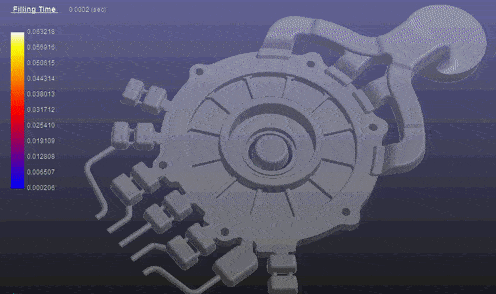What is Die Casting Mold?
 Die casting mold is a manufacturing tool that used to make die casting parts. It’s made from hardened steel, normally consists of cavity, core, and ejection system. For come complex parts, the mold tool would need additional sliders or lifters.
Die casting mold is a manufacturing tool that used to make die casting parts. It’s made from hardened steel, normally consists of cavity, core, and ejection system. For come complex parts, the mold tool would need additional sliders or lifters.
During the die casting process, the molten metal is poured or forced into the die casting mold cavity where the material cools and solidifies to become desired die casting parts.
The Terminology of Die Casting Mold
- Draft– A certain degree of angle that allows die casting product to fall off from mold tool easily.
- Parting Line– a small line left between the fitting area of mold core and cavity. It looks like a flash line.
- Gate– The material running channel that attached on die casting product
- Mold Core– The outstanding plate that mates with mold cavity to consist the die casting features.
- Mold Cavity– A recessed plate that allows molten material to fill in and solidify.
- Slide— A mechanical device to obtain some special features that can’t be directly produced by mold core and cavity side.
- Injection— A filling process by high pressure that forces the molten material into mold tool.
- Ejection Marks— Marks left by the ejection pins on the surface of die casting product. This mark caused by the small space between moveable pins and ejection plate.
- Ejection Pins— The moveable pins inside a mold tool that used to push off die casting product from mold tool.
- Runner— The material flowing channel in the die casting mold that starts from sprue and ends by die casting product.
- Overflow – An additional reservoir connects with die casting product that used to avoid or reduce injection bubble and other die casting defects.
- Sprue— A small hole in the die casting mold. It’s also an entrance of raw material to die casting runner and parts
- Vent— A small space that recessed from mold core and cavity so that air or gases can evacuate out from the mold when material filling process.
- Clamping Plate–a mold plate inside a mold tool that used to mount mold tool on die casting machine.
Die Casting Parts DFM and Refining :
 Draft is the a certain angle of the tooling core or parts to be easily released when die casting production process. All die cast surfaces that are parallel to the opening direction of the die require draft for the proper ejection of the casting from the die. Otherwise there must be a potential manufacturing risk for the die mold.
Draft is the a certain angle of the tooling core or parts to be easily released when die casting production process. All die cast surfaces that are parallel to the opening direction of the die require draft for the proper ejection of the casting from the die. Otherwise there must be a potential manufacturing risk for the die mold.
Fillet is round juncture of two surfaces that would have otherwise met at a sharp corner or edge. When die casting part design, experienced product designer must put some fillets on the optimized parts so as to remove undesirable edges and corners, as well for stress concentration consideration.
Pillar is designed to support some stand-offs surface or to assemble other parts with screws. Based on our experience, for maximum integrity and strength of the die casting reason, The thickness of pillar must be equal or exceed the universal wall thickness. Otherwise the pillar might be easily cracked.
Rib is designed to strength walls, surface, or other functional features, so that the target part will be strong enough for any work condition. For die casting manufacturing consideration, we sincerely comment our client can make the thickness ribs at 50%~80% of universal wall thickness. So as to eliminate or reduce shrinkage of the parts during the casting process.
Holes and windows We would specially advise adding proper draft on holes and window feature, because when die casting manufacturing, the perimeters of these features will grip to the die steel during solidification.
Mold Design
We are grouped with a sophisticated die casting team who has more than 20 years of solid work experience in die casting mold design and manufacturing, and our professional die casting mold makers are committed to offing customers a high efficient, durable, and economical die casting solution.
We have rich experience on die casting mold design and making with LKM, HASCO or DME standard. Our sophisticated mold designers in house who have over 15 year of die casting mold design experience, we consider every mold details so that there will be no problem for mass production. During the process, will work closely with client and provide DFM report, Moldflow analysis, 3D/2D Mould Drawing. A detail design checklist below will be performed and checkout carefully at us.
- We will design a best workable die casting process based on analysis of product material, structure, tolerance, and other special requirement.
- Define product layout, cavity, parting line, gate, runner, ejection pins, overflows.
- Check out if all of sliders/lifters are correctly located. If the movement of slider will go smoothly.
- Check out if the ejection mark and parting lines are designed properly(minimum and reasonable)
- Check out if there is any interference when mold is working.
- If the shrinkage rate is correctly design
- Check out mold cavity, slider number, and other mold accessories
Mold Flow Simulation
 It is commonly noted that the mold flow simulation can accurately predicate a cast component’s quality before product develops. This results in a reduction in pre-production sampling costs as optimized flow simulation leads to time, energy, material, and mold cost savings.
It is commonly noted that the mold flow simulation can accurately predicate a cast component’s quality before product develops. This results in a reduction in pre-production sampling costs as optimized flow simulation leads to time, energy, material, and mold cost savings.
At every beginning of each die casting development, our professional engineering team will utilize mold flow simulation software (Magmasoft Magma5.3) to analyze the casting feasibility and predicate any potential defect even the mold is not kicked-off. This action is very useful in predicting where Shrink is, deformation might be, and other unseeing risks. Based on the simulation data, our engineering team can see the air/gas entrapment, hot spots, and other potential design risks.
When the casting design is optimized, our engineers also utilize simulation software for the existing tool tied to machine parameters to view the metal flow through the gating, runner system, and cavity in the casting mold. Making subtle input changes into the mold flow software can provide immediate feedback on what changes need to be made to the die, process, or equipment. In this way, problem solving time is greatly reduced and often results are immediate. Moreover we can proactively reduce defects and scrap rate.



 Step 1: Mold Base, Steel, and Other Accessories Sourcing
Step 1: Mold Base, Steel, and Other Accessories Sourcing









